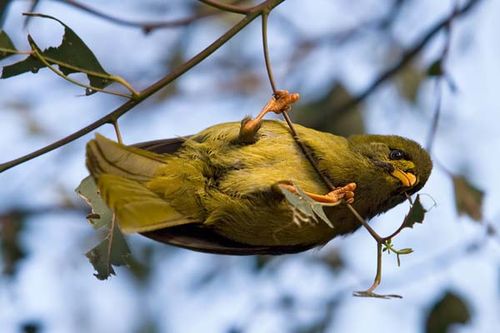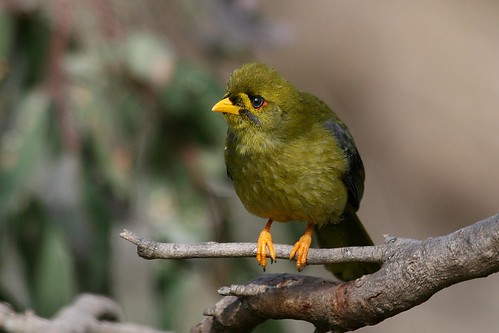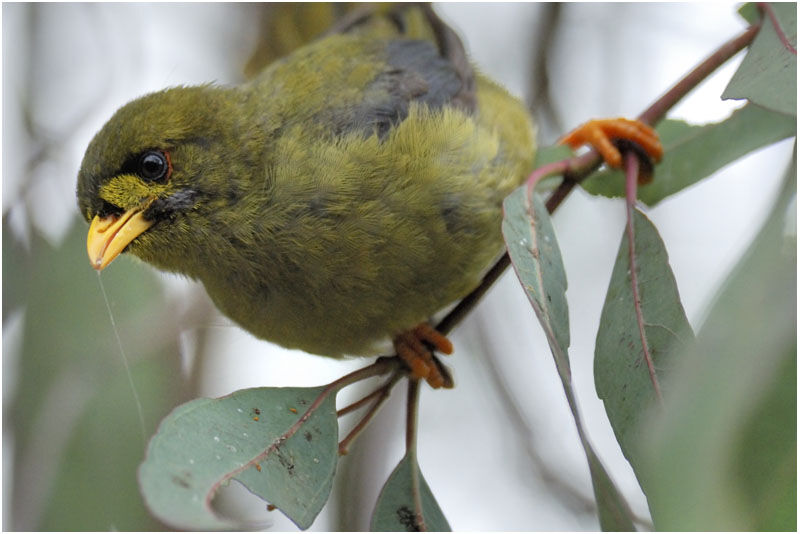Bell Miner Biography
The Bell Miner is the smallest of the miners and is a medium-large and solidly built honeyeater. It is mostly olive-green, with a short, down-curved, bright yellow bill, a red-orange bare eye patch and orange-yellow feet and legs. It has a squared off tail. Males are slightly larger, but otherwise the sexes are similar. Young birds are duller and browner, with a paler eye patch. More often heard than seen, the Bell Miner lives in large colonies and aggressively defend their territories against all intruders. Also commonly known as Bellbirds.








The Bell Miner is the smallest of the miners and is a medium-large and solidly built honeyeater. It is mostly olive-green, with a short, down-curved, bright yellow bill, a red-orange bare eye patch and orange-yellow feet and legs. It has a squared off tail. Males are slightly larger, but otherwise the sexes are similar. Young birds are duller and browner, with a paler eye patch. More often heard than seen, the Bell Miner lives in large colonies and aggressively defend their territories against all intruders. Also commonly known as Bellbirds.
The sound of Bell Miners calling in the bush is often greeted with a feeling of benign sentimentality, but this is not the case for the other species of birds trying to share the habitat with them. Bell Miners are territorial and pugnacious, so that when they move into a patch of forest they usually evict most of the other small birds. This has been exacerbated in recent years by Bell Miners expanding their range, thus exposing birds in new regions to their aggressive, domineering behaviour.
Endemic to eastern and south-eastern mainland Australia, the Bell Miner ranges from Gympie, Queensland, to Melbourne, Victoria, but is restricted to coastal and mountain regions.
Bell Miners feed as part of a colony, remaining in the canopy at or above eight metres from the ground. They mainly eat insects, especially psyllids and their lerps (sugary secretions used as protective shelters by the tiny psyllid insects) from the foliage of eucalypts. They also eat nectar and manna. It has been shown that Bell Miners maintain psyllid populations at high levels by protecting them from other birds and by maintaining sufficiently large territories so that they don't over-feed on the psyllids themselves.
Bell Miners have a complex social structure, based on breeding pairs which each have their own feeding range that overlaps with those of non-breeding members (e.g. their offspring), making up a colony of 8 - 200 birds. The breeding pairs generally mate for life and are 'obligate co-operative breeders', which means that they are always helped by between 1 and 20 'auxiliaries' in their parental duties. These helpers are usually young or unpaired birds, but may also include other breeding adults who are also raising their own young. They are usually closely related to the breeding pair, most often to the male. Interestingly, males of breeding age are the most 'helpful' auxiliaries, often helping more than one breeding pair. The helpers defend the nest, feed the young, clean the nest and sometimes feed the female when she is incubating the eggs. Both parents also engage in all nest and feeding duties, but the female builds the thin, cup-shaped nest and incubates the eggs alone. Predators of eggs and young include: Grey Currawongs, Laughing Kookaburras, Common Blackbirds, Brown Goshawks, ravens, Eastern Brown Snake and Copperhead. Can also be parasitised by cuckoos, including the Pallid Cuckoo and the Fantailed Cuckoo.
Bell Miner

Bell Miner

Bell Miner

Bell Miner

Bell Miner

Bell Miner

Bell Miner

Bell Miner

Bell Miner
Bell Birds,Australia
Ptaki Australii :Manorina melanophyrus 01
No comments:
Post a Comment